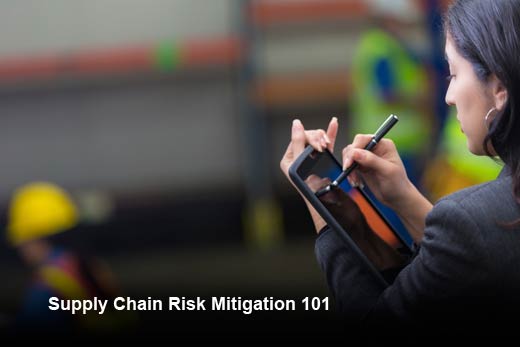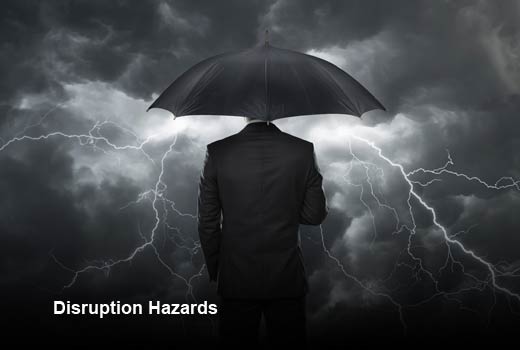How’s the weather? While that may seem like an everyday conversation-starter for the average Joe, that question can stir up angst and distress for logistics and supply chain professionals.
The reality is that many things can go wrong in today’s extended supply chain environment. Companies encounter delays, disruptions, safety threats, financial insolvency, environmental concerns, interconnected risks and other supply chain risks that can be unexpected and can take companies weeks or months to recover from.
While risk mitigation can be an intimidating endeavor, especially when it comes to the complexities of supply chain management, it doesn’t need to be. By identifying their biggest risks and coming up with mitigation strategies, companies can navigate their way through the supply chain, safely and efficiently. Are you up to speed on common supply chain hazards, with a best-practices approach to mitigating those risks? If not, Avetta has outlined tips that organizations can take to shore up their supply chain. Welcome to supply chain risk mitigation 101.

Supply Chain Risk Mitigation 101
Click through for tips on how organizations can reduce risk and navigate their way through the supply chain safely and efficiently, as identified by Avetta.

Supply Chain Hazard #1: Delays
Delays can cause a number of operational problems. From border control issues and delays between the U.S. and Canada, to delays in material flows when a supplier cannot respond to demand changes, these problems are an essential area to control. Collecting ideas for ways to eliminate a specific delay, and compiling that information in a centralized area where it can be easily accessed by others, will help mitigate the risks companies face when a delay occurs.

Supply Chain Hazard #2: Disruption Hazards
Disruptions to material flows are unpredictable and damaging. In March 2000, lightning hit a power line and started a fire at the mobile phone microchip manufacturing firm, Nokia. As a result, the company began switching its chip orders to other Japanese and American suppliers. Thanks to its multiple-supplier strategy and responsiveness, Nokia’s production suffered little during the crisis. In order to minimize problems associated with disruption hazards, companies should have a contingency plan in place to protect their supply chain management procedures.

Supply Chain Hazard #3: Safety Threats
The fact is, every supplier is a potential liability, and a single misstep in the supplier selection process can cost you billions of dollars in lawsuits, damages and stoppage costs. However, companies can take several steps to bolster safety, such as having emergency action plans, effective communication, effective contractor screening and more. At the end of the day, safety is essential to the supply chain industry, and companies must insist on sending workers home safely each day.

Supply Chain Hazard #4: Financial Insolvency
The more you rely on suppliers, the more dangerous their insolvency is to your firm. Take Land Rover, for example. In 2001, it was caught off-guard after its single chassis supplier, UPF-Thompson, declared bankruptcy. If we can learn anything from this example, it’s to protect yourself from bankruptcy. Start by collecting financial records as part of your supply chain management process. Then be sure to share this information internally with the parties who are involved in the hiring process. Lastly, store that collected information in a central location, where it can be easily and quickly accessed.

Supply Chain Hazard #5: Sustainability Concerns
To effectively control the sustainability aspect of their supply chain management process, firms simply cannot afford to see the following issues in suppliers: ecologically destructive practices, excessive carbon footprint, energy and non-renewables consumption, just to name a few. Be sure to focus on sustainability in supply chain management by remembering that suppliers’ ecological, financial and ethical impacts are effectively yours. To avoid any negativity associated with your organization, ask suppliers to agree to your global sustainable practices (anti-bribery, corruption), provide total annual carbon emissions in the most recent year, total annual greenhouse gas emissions in the most recent year, a business continuity plan, and publicly available guidelines that address sustainability.

Supply Chain Hazard #6: Interconnected Risks
The final hazard that firms need to concern themselves with is interconnected risk. Oftentimes, firms focus on a single risk area and do not consider how an incident can affect more than one area of the company. But by understanding the variety and interconnectedness of supply chain risks, managers can tailor balanced, effective risk reduction strategies for their companies. So, firms, be sure to strategize the following: prevent and prepare without reducing profits, seek additional profits for any level of risk protection and preparedness, and attain the highest achievable profits for varying levels of supply-chain risk.















